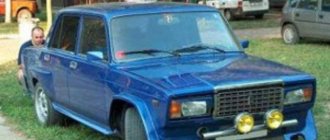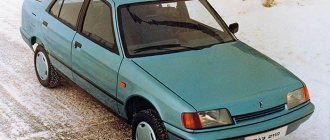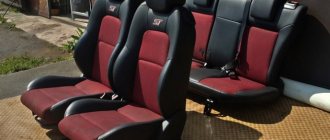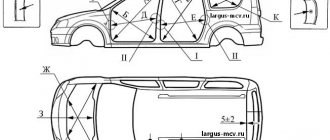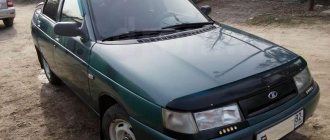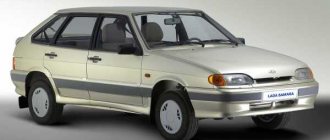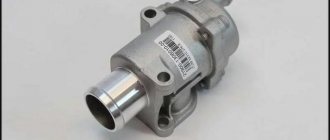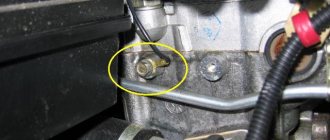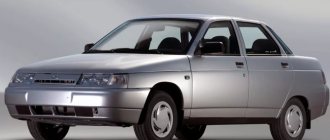Technical characteristics of the VAZ 2110 “Ten”
Four-door front-wheel drive sedan. Produced at AvtoVAZ from 1995 to 2007.
The first VAZ-2110s were produced on June 27, 1995 in AvtoVAZ pilot production, mass production began in August 1996, and sales began in November of the same year. By that time, technology in the global automotive industry had reached a new level, and the breakthrough model for the late 80s could no longer be called an absolute novelty. However, despite this, as well as some complaints about the quality of production in the 90s, it still became a step forward for the domestic automobile industry.
Unlike the Lada and Samara, the VAZ-2110 was positioned as a higher-class car, quite modern and competitive both externally and internally. In particular, an electronic engine control system was installed on the car (although the first VAZ-2110s were carburetor) and a diagnostic unit (on-board computer), it was possible to install power steering and electric windows, galvanized metal was used in body parts, and a new painting technology was used bodies, etc. The appearance of the “ten” marked a new stage in the development of the domestic automobile industry.
In March 2007, on the main assembly line of AvtoVAZ, serial production of cars of the new LADA Priora family was launched, which was a deep restyling of the “tens” and designed to replace the last one in the model range, and the “tens” were produced in parallel. The last set of VAZ-2110 was assembled on the Togliatti assembly line on October 15, 2007. VAZ-2111 (station wagon) and VAZ-2112 (hatchback) were produced for another two years and a year, respectively.
Until 2014, VAZ-2110s were assembled under license from AvtoVAZ vehicle kits at the Bogdan Corporation automobile plant in the Ukrainian city of Cherkassy under the Bogdan brand. A pickup truck based on the VAZ-2110 was also developed.
VAZ 2110
"Ten"
Performance characteristics of the VAZ 2110 ten
- Maximum speed: 180 km/h
- Acceleration time to 100 km/h: 12.5 s
- Fuel consumption per 100 km in the city: 8.8 l
- Fuel consumption per 100 km on the highway: 5.5 l
- Fuel consumption per 100 km combined cycle: 7.2 l
- Gas tank volume: 43 l
- Vehicle curb weight: 1040 kg
- Permissible gross weight: 1495 kg
- Tire size: 175/60 R14
- Rims size: 5Jx13
Engine characteristics
- Location: front, transverse
- Engine capacity: 1500 cm3
- Engine power: 94 hp
- Number of revolutions: 5600
- Torque: 128/3600 N*m
- Power system: Distributed injection (multipoint)
- Turbocharging: no
- Gas distribution mechanism: DOHC
- Cylinder arrangement: In-line
- Number of cylinders: 4
- Cylinder diameter: 82mm
- Stroke: 71 mm
- Compression ratio: 9.5
- Number of valves per cylinder: 4
- Recommended fuel: AI-95
Brake system
- Front brakes: Disc
- Rear brakes: Drum
Steering
Steering Type: Rack and Pinion
Transmission
- Drive: Front
- Number of gears: manual transmission - 5
6. Suspension
- Front suspension: independent, spring
- Rear suspension: semi-independent, spring
7. Body
- Body type: sedan
- Number of doors: 4
- Number of seats: 5
- Machine length: 4265 mm
- Machine width: 1680 mm
- Machine height: 1420 mm
- Wheelbase: 2492 mm
- Front track: 1400 mm
- Rear track: 1370 mm
- Ground clearance (clearance): 170 mm
- Trunk volume: 450 l
Production
Year of manufacture: from 1996 to 2007
Service
This section includes changing the oil and adjusting the valves (8 and 16 valve engines).
Experts recommend changing the oil every 15 thousand kilometers. If you do not comply with these requirements, the power unit will quickly fail. The fact is that oil loses its properties over time and accumulates many harmful substances. Without changing the oil and flushing the engine, the car will not last long. The VAZ 2110 engine mounts are also being replaced.
Procedure during draining:
- Unscrew the plug located under the bottom of the power unit. In this case, you can use a special key;
- Carefully drain the used oil so that it does not get on your skin. If you are not careful, you can get a very serious burn to the skin as the oil is very hot;
- Next, you can wipe the bottom of the power unit to get rid of any remaining oil;
- Screw the plug back;
- We unscrew the oil filter, which is located under the hood of the vehicle. To make your work easier, you can use a set of keys. We also replace the engine mount;
- Coat all filter gaskets with a thin layer of oil. This is necessary so that the filter can easily fit into the fitting place. The force applied should be monitored very carefully. If you exaggerate with force, you will strip the thread.
Actions during pouring:
- Carefully unscrew the filler cap;
- We take new oil in our hands and begin to pour it into the neck in the amount of three liters. In this case, you need to monitor the level so as not to overfill. Otherwise, the oil will end up in unnecessary areas of the engine;
- Next, you can start the power unit and wait a few minutes until the system warms up and the oil goes through several circles. Only after 20 minutes can you check the oil level. If it is not enough, then feel free to add more. In other cases, the process is completed, you can screw on the cover and put in the replaced engine mount;
- We also check the dashboard. The Check Engine light should not be on.
ADJUSTMENT OF VALVES
This process is the most complex and quite interesting. The performance of the power unit and its stability will depend on the correctness of the actions.
If you want to tune the VAZ 2110 engine, then adjusting the valves can be classified as some kind of tuning.
The adjustment is carried out using the device:
- Open the valve mechanism cover and completely remove the timing belt cover;
- We install a device that will allow you to easily carry out all the actions;
- We put the necessary marks on both the crankshaft and the camshaft. They are necessary for proper adjustment. You should also check the timing belt. It should be taut, not hanging;
- Checking the gap;
- Next, unscrew the washer and replace it with a new one according to the formula:
Н = В+(А–С), mm,
- where A is the measured gap;
- B – thickness of the removed washer;
- C – nominal gap;
- N – thickness of the new washer.
Weight of VAZ 2110 bodies
Model body weight:
Body weight of modifications of the VAZ 2110 sedan (1995 – 2009):
- 1010 kg, 1020 kg, 1100 kg, 1330 kg.
Model body information:
The body of the VAZ 2110 is load-bearing and has a closed power structure, that is, it forms a closed contour (due to the presence of a roof) and brings together all vertical power elements.
All parts of the VAZ 2110 body are made by stamping from low-carbon, thin-sheet steel (thickness from 0.7 mm to 0.9 mm), heavily loaded parts are made from sheet 1.2 mm thick.
Important: according to the technical documentation, one of the heaviest bodies is the VAZ 2110 21109 Consul 1.5 MT sedan, its weight is 1330 kg.
Other names:
Until 2014, the VAZ 2110 model was assembled under license from AvtoVAZ vehicle kits at the Bogdan Corporation automobile plant under the Bogdan-2110 brand.
Subtleties of the model range:
The model is equipped with an electronic engine control system, a diagnostic unit (on-board computer), power steering, electric windows, and a new body painting technology is used.
Years of production Years of production: 1995-2007.
| Body weight VAZ 2110 | |
| Parameter | Meaning |
| 02 l., Petrol, Mechanics, 5 speed, Front | |
| Curb weight: | 1100 (kg) |
| Bare weight: | 275-330 (kg) |
| Permissible gross weight: | 1525 (kg) |
| 1.3 l., Petrol, Mechanical, 5 speed, Front | |
| Curb weight: | 1010 (kg) |
| Bare weight: | 250-300 (kg) |
| Permissible gross weight: | 1485 (kg) |
| 1.5 l., Petrol, Mechanical, 5 speed, Front | |
| Curb weight: | 1050 (kg) |
| Bare weight: | 275-330 (kg) |
| Permissible gross weight: | 1525 (kg) |
| 1.6 l., Petrol, Mechanical, 5 speed, Front | |
| Curb weight: | 1040 (kg) |
| Bare weight: | 250-300 (kg) |
| Permissible gross weight: | 1515 (kg) |
Caution: the data presented separately for the body are indicative, and may differ from the real ones by 15% in one direction or the other.
Characteristics of VAZ 2110
The VAZ 2110, or Lada 110, is a four-door sedan equipped with front-wheel drive and distinguished by a design that is different from other models. AvtoVAZ began production of the Lada 110 in 1996 and ended in 2007, but the Ukrainian LuAZ plant is still producing the car under the Bogdan brand.
Simultaneously with the Lada 110, several modifications were produced: engines with 8 and 16 valves. The maximum speed of the car increased to 170 and 180 km/h on 8-valve and 16-valve engines, respectively. The VAZ 2110 has excellent technical characteristics that allow the car to be used in almost any conditions.
The VAZ 2110 is the upper price segment in the AvtoVAZ car line, so it has a number of new and useful features: an immobilizer, an on-board control system with a diagnostic unit, a gasoline vapor detection system, electric lifts and power steering.
Characteristics of VAZ 2110
| Engine | 1.6 l, 8kl (Euro-2) | 1.6 l, 16cl (Euro-2) | 1.6 l, 16cl (Euro-3) |
| Length, mm | 4265 | 4265 | 4265 |
| Width, mm | 1680 | 1680 | 1680 |
| Height, mm | 1420 | 1420 | 1420 |
| Base, mm | 2492 | 2492 | 2492 |
| Front wheel track, mm | 1410 | 1410 | 1410 |
| Rear wheel track | 1380 | 1380 | 1380 |
| Load capacity, kg | 475 | 475 | 475 |
| Luggage compartment volume, dm3 | 450 | 450 | 450 |
| Permissible total weight of a towed trailer with brakes, kg | 1000 | 1000 | 1000 |
| Permissible total weight of a towed trailer without brakes, kg | 500 | 500 | 500 |
| Wheel formula / drive wheels | 4x2 / front | ||
| Car layout diagram | Front-wheel drive, front engine, transverse | ||
| Body type / number of doors | Sedan/4 | ||
| engine's type | injection gasoline, four-stroke | ||
| Engine displacement, cm3 | 1596 | 1596 | 1596 |
| Supply system | distributed injection with electronic control | ||
| Number and arrangement of cylinders | 4, in-line | ||
| Maximum power, kW (hp) / rev. min. | 59 (80) / 5200 | 65,5 (89) / 5000 | 65,5 (89) / 5000 |
| Maximum torque, Nm at rpm | 120 / 2700 | 131 / 3700 | 131 / 3700 |
| Maximum speed, km/h | 170 | 180 | 180 |
| Fuel consumption by driving cycle, l/100 km | 7,2 | 7,2 | 7,2 |
| Fuel | AI-92 (min) | AI-92 (min) | AI-92 (min) |
| Transmission | mechanical | ||
| Number of gears | 5 forward, 1 reverse | ||
| Main gear ratio | 3,7 | 3,7 | 3,7 |
| Acceleration to 100 km/h, s | 13,5 | 12 | 12 |
| Steering | with hydraulic booster, rack and pinion steering mechanism | ||
| Tires | 175/65 R13 | 175/65 R13 | 175/65 R14 185/60 R14 |
| Fuel tank capacity, l | 43 | 43 | 43 |
Modifications of VAZ 2110
- VAZ-21100 (8-valve petrol carburetor engine with a working volume of 1.5 liters was produced from 1996 to 2000);
- VAZ-21101 (8-valve gasoline injection engine with a working volume of 1.6 liters, produced since 2004);
- VAZ-21102 (8-valve gasoline injection engine with a working volume of 1.5 liters);
- VAZ-21103 (16-valve gasoline injection engine with a working volume of 1.5 liters, produced since 2001);
- VAZ-21103M (16-valve gasoline injection engine with a working volume of 1.5 liters, produced since 2001);
- VAZ-21104 (16-valve petrol injection engine with a working volume of 1.6 liters, produced since 2004);
- VAZ-21104M (16-valve gasoline injection engine with a working volume of 1.6 liters, produced since 2004);
- VAZ-21106 GTI 2.0 16V (16-valve Opel C20XE petrol engine with a displacement of 2.0 liters);
- VAZ-21106 Coupe (variation of a car in a coupe body);
- VAZ-21107 (Sports modification of the VAZ-21106 car);
- VAZ 21108 “Premier” (extended by 17.5 cm, has additional handles on the rear doors, enhanced sound insulation);
- VAZ 21109 “Consul” (limousine with five doors, a glass roof and an interior made of wood; non-serial production);
- VAZ 2110 RPD (Sports variation of the VAZ-2110 car with a rotary piston engine).
In 2002, MAI specialists developed the VAZ 2110 with a continuously variable transmission (VT1 variator).
From 2005 to 2007, only modifications 21101 and 21104 were produced.
What to choose
Before moving directly to choosing a VAZ roof rack, it is important to clearly understand two points:
- what do you plan to transport;
- what is the mounting system of your car?
Depending on the purpose of transportation, there are:
- Open trunks are suitable for transporting large, bulky or dirty cargo over short distances. They are a rectangular base with fastening elements. They are budget-friendly, but they reduce the aerodynamics of the car and, accordingly, increase fuel consumption.
- Closed trunks - used for frequent long-distance trips and in cases where it is necessary to protect luggage from adverse conditions, moisture, dust, etc. They have the form of baskets or boxes - closed containers. One of the advantages is increased aerodynamics, and the disadvantage is high cost.
- Specialized racks for transporting sports equipment (bicycles, skis, etc.) - narrow functionality. Most often it belongs to the middle price segment. Aerodynamics are reduced due to the specific shape of the load. The installation is noted to be difficult.
Depending on the mounting method, VAZ luggage racks are:
- standard – installed on recesses on the roof, according to the car manufacturer’s instructions;
- roof rails;
- integrated roof rails;
- attached to the doorway - this is how a roof rack is installed on the roof of a VAZ 2112, 2110;
- with mounting on a T-shaped profile;
- with fastening to the drain;
- on magnets - rare, has a relatively low load capacity;
- through the interior (inflatable trunk).
This does not limit the process of selecting a luggage rack. It is important to pay attention to the material of manufacture. You don't have to settle for soft metal car racks. Preference is given to steel types with galvanized coating or high-quality plastic.
Also, consider the manufacturer's reputation. And the option remains to make a VAZ roof rack yourself.
Eurodetail
One of the largest companies in the country for the production of luggage systems is Eurodetal. It has been on the market since 1998. Production is entirely based on the company’s own developments and uses materials only from Russian partners. The assortment is rich, there are luggage racks for almost any modern car.
Modifications
| Name | Year of issue | |
| LADA 110 (2110) 1.5 | 01.1995 — 12.2005 | Characteristics |
| LADA 110 (2110) 1.5 | 01.1995 — 12.2005 | Characteristics |
| LADA 110 (2110) 1.5 16V | 01.1995 — 12.2005 | Characteristics |
| LADA 110 (2110) 2.0 i | 08.1996 — 07.2000 | Characteristics |
| LADA 110 (2110) Wankel | 06.1997 — 09.2004 | Characteristics |
| LADA 110 (2110) 1.5 | 10.2000 — 12.2005 | Characteristics |
| LADA 110 (2110) 1.5 16V | 10.2000 — 12.2010 | Characteristics |
| LADA 110 (2110) 1.6 | 01.2000 — 12.2012 | Characteristics |
| LADA 110 (2110) 1.6 | 01.2000 — 04.2007 | Characteristics |
Technical characteristics of VAZ 2110
| Automobile | Lada 2110 | ||||
| Modification name | VAZ-2110 | VAZ-21102 | VAZ-21103 | VAZ-21101 | VAZ-21104 |
| Body type | sedan | ||||
| Number of places | 5 | ||||
| Length, mm | 4265 | ||||
| Width, mm | 1680 | ||||
| Height, mm | 1420 | ||||
| Wheelbase, mm | 2492 | ||||
| Curb weight, kg | 1010 | 1020 | 1050 | 1020 | 1040 |
| engine's type | petrol | petrol, fuel injection | petrol, fuel injection | petrol, fuel injection | petrol, fuel injection |
| Location | front, longitudinal | front, longitudinal | front, longitudinal | front, longitudinal | front, longitudinal |
| Number and arrangement of cylinders | 4, in a row | 4, in a row | 4, in a row | 4, in a row | 4, in a row |
| Working volume, cubic meters cm. | 1499 | 1499 | 1499 | 1596 | 1596 |
| Number of valves | 8 | 8 | 16 | 8 | 16 |
| Maximum power, l. With. / rpm | 73 / 5600 | 78 / 5400 | 93 / 5600 | 81 / 5200 | 89 / 5000 |
| Maximum torque, Nm / rpm | 109 / 3400 | 116 / 3000 | 128 / 3700 | 120 / 2700 | 131 / 3700 |
| Transmission | manual, 5-speed | ||||
| Drive unit | front | ||||
| Tires | 175/70 R13 | 175/65 R14 | 175/70 R13 | 175/65 R14 | |
| Maximum speed, km/h | 165 | 170 | 185 | 170 | 180 |
| Acceleration time 0-100 km/h, s | 14 | 14 | 12,5 | 13,5 | 12 |
| Fuel consumption in the combined cycle, l/100 km | 7,6 | 7,2 | 7,2 | 7,5 | 7,2 |
| Fuel tank capacity, l | 43 | ||||
| Fuel type | petrol | ||||
Tuning
And in conclusion, I would like to say about tuning the VAZ 2110 engine.
In the VAZ 2110, engine tuning is very easy to do. To do this, you only need a tool and a room. This process can be done not only in a specialized workshop, but also in your garage.
Tuning a VAZ 2110 engine requires only a set of tools and patience:
- The first step is to simply replace the camshaft with a better one. Due to this, power will increase and engine performance will improve.
- You can also install a new crankshaft to increase the volume of the unit. If this is not done, then further tuning of the VAZ 2110 engine will be in vain.
- The installation of a compressor is quite simple. This unit allows you to increase power and get good torque.
- It is worth noting that tuning the VAZ 2110 engine can be done by anyone. This does not require special experience or skills. It is enough to know the structure of the car and have locksmith skills. Experts recommend installing a high-quality stock piston so that it can withstand about 0.5 bar.
Review of VAZ-2110
The VAZ-2110 sedan has been produced since 1995.
Initially, the car was equipped with a 1.5 liter eight-valve carburetor engine. Subsequently, only injection engines were installed on the “ten”: 1.5-liter eight-valve (modification VAZ-21102) or 16-valve (21103); 1.6-liter eight-valve (21101) or 16-valve (21104). In addition to the sedan, versions with hatchback (VAZ-2112) and station wagon (VAZ-2111) bodies were also produced. In 2007, after the appearance of the Priora, the production of the “ten” in Tolyatti was curtailed. However, their production continued in Ukraine from vehicle kits supplied by AvtoVAZ. In 2010, sales of Ukrainian-assembled cars began in Russia under the name “Bogdan 2110” (on the Ukrainian market the car is sold under the Lada brand).
Source
- wroom.ru/cars/lada/2110#1
- autodelo.info/catalog/auto/model/1993/
- wikiweight.info/tehnika/kuzova/massa-kuzovov-vaz-2110.html
- zen.yandex.ru/media/id/5d42cf85f0d4f400ae3f3ecf/tehnicheskie-harakteristiki-vaz-2110-desiatka-5d45b901fbe6e700adf3f88d
- carexpert.ru/models/vaz/2110/tech/vaz100s.htm
How to install
To attach the trunk to a VAZ 2110 car, it is not necessary to visit a car service center. You can install the roof rack yourself. Procedure:
- We install supports for further installation of transverse arches. It is important to check that the support fits onto the seal. Otherwise, there is a risk of damaging the car's paintwork.
- Pull out the control knob. Carefully holding the support, turn the adjuster until the structure fits tightly to the machine. Do not overdo it so as not to deform the beam. We repeat this procedure with another support.
- We check the geometry: it is necessary to secure the supports evenly. We monitor whether they lie tightly.
- We install the cross members and check the geometry again.
- We fix the box, mesh or other structure.
